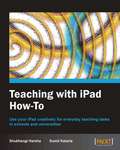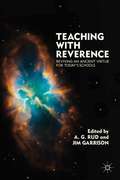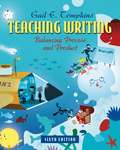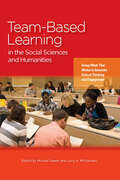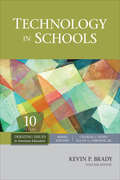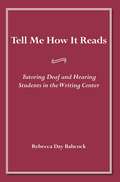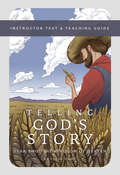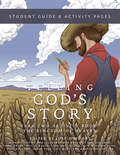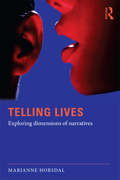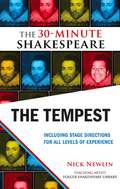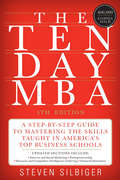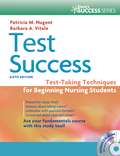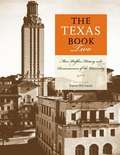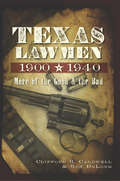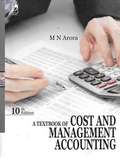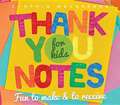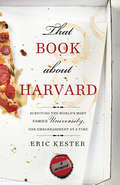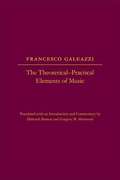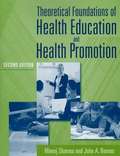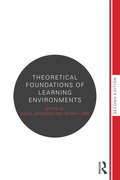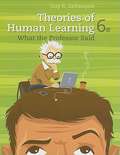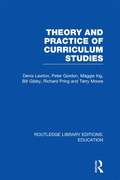- Table View
- List View
Teaching What You Don’t Know
by Therese HustonYour graduate work was on bacterial evolution, but now you're lecturing to 200 freshmen on primate social life. You've taught Kant for twenty years, but now you're team-teaching a new course on “Ethics and the Internet.” The personality theorist retired and wasn't replaced, so now you, the neuroscientist, have to teach the "Sexual Identity" course. Everyone in academia knows it and no one likes to admit it: faculty often have to teach courses in areas they don't know very well. The challenges are even greater when students don't share your cultural background, lifestyle, or assumptions about how to behave in a classroom. In this practical and funny book, an experienced teaching consultant offers many creative strategies for dealing with typical problems. How can you prepare most efficiently for a new course in a new area? How do you look credible? And what do you do when you don't have a clue how to answer a question? Encouraging faculty to think of themselves as learners rather than as experts, Therese Huston points out that authority in the classroom doesn't come only, or even mostly, from perfect knowledge. She offers tips for introducing new topics in a lively style, for gauging students' understanding, for reaching unresponsive students, for maintaining discussions when they seem to stop dead, and -yes- for dealing with those impossible questions. Original, useful, and hopeful, this book reminds you that teaching what you don't know, to students whom you may not understand, is not just a job. It's an adventure.
Teaching with iPad How-to
by Shubhangi Harsha Sumit KatariaTeaching with iPad how-to is a crisp and systematic guide organized into various step-by-step recipes that will enable you to utilize the power of your iPad to make your daily teaching tasks easy and interesting. This book is ideal for school and university teachers who have access to an iPad and are willing to make their profession all the more fun and easy for themselves. It is assumed that the reader has basic knowledge of how to use the iPad, access the Appstore and download apps.
Teaching with Reverence
by A. G. Rud Jim GarrisonReverence is a forgotten virtue in teaching and learning. When taken in a broader spiritual sense, it is often associated with a mute and prim solemnity. The essays gathered here examine reverence as a way to understand some of the spiritual dimensions of classroom teaching.
Teaching Writing: Balancing Process and Product (Sixth Edition)
by Gail E. TompkinsThis best selling text by Gail Tompkins thoroughly examines genres and instructional procedures with a strong new focus on differentiating instruction to ensure success for all writing students. New chapters on the writer's craft and on writing across the curriculum offer detailed information on the six traits of good writing as well as writing in content areas, and new features provide insight into teaching English learners and using technology meaningfully in the writing classroom.
Team-Based Learning in the Social Sciences and Humanities: Group Work that Works to Generate Critical Thinking and Engagement
by Edited by Michael Sweet and Larry K. MichaelsenTeam-Based Learning (TBL) is a unique, powerful, and proven form of small-group learning that is being increasingly adopted in higher education. Teachers who use TBL report high levels of engagement, critical thinking, and retention among their students. TBL has been used successfully in both small and large classes, in computer-supported and online classes; and because it is group work that works, it has been implemented in nearly every discipline and in countries around the world.This book introduces the elements of TBL and how to apply them in the social sciences and humanities. It describes the four essential elements of TBL – readiness assurance, design of application exercises, permanent teams, peer evaluation – and pays particular attention to the specification of learning outcomes, which can be a unique challenge in these fields.The core of the book consists of examples of how TBL has been incorporated into the cultures of disciplines as varied as economics, education, literature, politics, psychology, and theatre. The authors explain why they felt a need to change how they taught and why they chose TBL. Furthermore, each chapter provides examples of the assignments and exercises they use to help their students achieve the specific learning outcomes of their courses.At a time of increasing course sizes, and emphasis on learning outcomes, TBL offers the means to meet such demands while connecting students to their coursework, and stimulating their intellectual engagement.
Technology in Schools
by Kevin P. BradyEducation of America's school children always has been and always will be a hot-button issue. From what should be taught to how to pay for education to how to keep kids safe in schools, impassioned debates emerge and mushroom, both within the scholarly community and among the general public. This volume in the point/counterpoint Debating Issues in American Education reference series tackles the topic of technology in schools. Fifteen to twenty chapters explore such varied issues as the digital divide, electronic textbooks, impacts on curricula, privacy on school computers, web censorship, and more. Each chapter opens with an introductory essay by the volume editor, followed by point/counterpoint articles written and signed by invited experts, and concludes with Further Readings and Resources, thus providing readers with views on multiple sides of technology issues within America's schools and pointing them toward more in-depth resources for further exploration.
Tell Me How It Reads: Tutoring Deaf and Hearing Students in the Writing Center
by Rebecca Day BabcockDeaf students are attending mainstream postsecondary institutions in increasing numbers, raising the stakes for the complicated and multifaceted task of tutoring deaf students at these schools. Common tutoring practices used with hearing students do not necessarily work for deaf people. Rebecca Day Babcock researched and wrote Tell Me How It Reads: Tutoring Deaf and Hearing Students in the Writing Center to supply writing instructors an effective set of methods for teaching Deaf and other students how to be better writers. Babcock's book is based on the resulting study of tutoring writing in the college context with both deaf and hearing students and their tutors. She describes in detail sessions between deaf students, hearing tutors, and the interpreters that help them communicate, using a variety of English or contact signing rather than ASL in the tutorials. These experiences illustrate the key differences between deaf-hearing and hearing-hearing tutorials and suggest ways to modify tutoring and tutor-training practices accordingly. Although this study describes methods for tutoring deaf students, its focus on students who learn differently can apply to teaching writing to Learning Disabled students, ESL students, and other students with different learning styles. Ultimately, the well-grounded theory analysis within Tell Me How It Reads provides a complete paradigm for tutoring in all writing centers.
Telling God's Story, Year Two: Instructor Text & Teaching Guide (Telling God's Story)
by Peter EnnsWeekly religion lessons for second-graders, scripted for parents and teachers to make preparation and instruction straightforward and simple. The second in a twelve-year series designed to take young students from elementary through high school, Telling God's Story, Year Two provides scripted weekly lessons for second graders and the adults who teach them. Each weekly lesson provides pithy, content-filled background information for the teacher, a biblical passage from one of the four Gospels to read aloud, and a scripted explanation of the passage designed especially for children to grasp with ease.
Telling God's Story, Year Two: Student Guide & Activity Pages (Telling God's Story)
by Justin MooreHost a feast like ones Jesus and his disciples might have eaten. Defend a flock from wolves. Learn about compassion by playing the Good Samaritan Game, and re-create Jesus' final days with the Passion Week comic strip. These lesson plans, designed to accompany the weekly lessons laid out in Telling God's Story: Instructor Text and Teaching Guide, Year Two (sold separately), provide enough additional activities to fill out an entire week of home school or private school study. A core set of activities is also provided for the use of Sunday School teachers. Coloring pages accompany each lesson and accurately reflect the historical setting of the original stories, while a full range of crafts, games, and activities help young students understand and remember.
Telling Lives: Exploring dimensions of narratives
by Marianne HorsdalBoth interest in and understanding of narrative analysis had developed rapidly in recent years and is now a mainstream element of research across many disciplines. In the groundbreaking Telling Lives: Exploring dimensions of narratives, the author illustrates as many facets as possible of the stories people tell about their lives. She demonstrates
Telugu class 7 (Tene Chinukulu 2) - Telangana Board: తెలుగు తరగతి 7 (తేనే చినుకులూ 2) - తెలంగాణ బోర్డు
by TscertThis is the text book prescribed for Telugu to the students of 7th class, in Telangana.
Telugu (Nava Vasantham 1) class 6 - Andhra Pradesh Board: తెలుగు (నవ వసంతం 1) 6 వ తరగతి - ఆంధ్రప్రదేశ్ బోర్డు
by ApscertThis is the text book prescribed for Telugu subject to the students of 6th class in Andhra Pradesh.
The Tempest
by Nick NewlinThe Tempest: The 30-Minute Shakespeare offers eight scenes from this rich comedy. Beginning with the magical storm and shipwreck, this adaptation includes the uproarious discovery of the monster Caliban and his plot to kill Prospero. Included are the heartfelt marriage vows between Ferdinand and Miranda, the disguised antics of fairy Ariel, and Prospero's poetic abjuration of his rough magic. The edition includes a preface by Nick Newlin containing helpful advice on how to put on a Shakespeare performance in a high school class with novice actors as well as an appendix with suggestions for the specific play and recommendations for further resources.
The Ten-Day MBA 4th Ed.: A Step-By-Step Guide To Mastering The Skills Taught In America's Top Business Schools
by Steven A SilbigerRevised and updated to answer the challenges of a rapidly changing business world, the 4th edition of The Ten-Day MBA includes the latest topics taught at America's top business schools, from corporate ethics and compliance to financial planning and real estate to leadership and negotiation. With more than 400,000 copies sold around the world, this internationally acclaimed guide distills the lessons of the most popular business school courses taught at Harvard, Stanford, the University of Pennsylvania, the University of Chicago, Northwestern, and the University of Virginia. Author Steven A. Silbiger delivers research straight from the notes of real MBA students attending these top programs today—giving you the tools you need to get ahead in business and in life.
Test Success: Test-taking Techniques for Beginning Nursing Students (6th Edition)
by Barbara A. Vitale Patricia M. NugentThe road to nursing success begins here! A complete review of core concepts. More than 800 questions (Alternate format, too!) Test-taking hints and rationales for correct and incorrect answers.
The Texas Book Two
by David DettmerIn every corner of the sprawling enterprise that is the University of Texas at Austin, you will find teaching, research, artistic creation, and sports achievement that are among the best in the world. Mandated by the Texas constitution to be "a university of the first class," UT Austin strives for excellence across the curriculum, from the most traditional of liberal arts disciplines to the cutting edge of science and technology. For Texans interested in progress, whether students of the university or members of the public, there are few pleasures greater than uncovering the intellectual treasures that can be found by exploring the university's "Forty Acres" and all that they contain. The Texas Book, edited by Richard A. Holland and published in 2006, offered the first in-depth exploration of UT's history and traditions through a collection of profiles, histories, and reminiscences. Now The Texas Book Two continues the story, with a variety of contributors recalling particular events and personalities that have helped shape the university and the people whose lives it has touched. Twenty-one essays present personalities such as John A. Lomax, Anna Hiss, J. R. Parten, Harvey Penick, John W. Hargis, and Jorge Luis Borges; accounts of legislative battles and debates over campus architecture; histories of crown jewels such as the McDonald Observatory and Austin City Limits; and the reminiscences of Barbara Smith Conrad, Sam Hurt, and Cat Osterman, among others.
Texas Lawmen, 1900-1940: More of the Good and the Bad (True Crime Ser.)
by Clifford R. Caldwell Ron DelordLawlessness in Texas did not end with the close of the cowboy era. It just evolved, swapping horses and pistols for cars and semiautomatics. From Patrolman "Newt" Stewart, killed by a group of servicemen in February 1900, to Whitesboro chief of police William Thomas "Will" Miller, run down by a vehicle in the line of duty in 1940, Ron DeLord and Cliff Caldwell present a comprehensive chronicle of the brave--and some not so brave--peace officers who laid down their lives in the service of the State of Texas in the first half of the twentieth century.
A TextBook of Cost and Management Accounting 10 Edition - PART-I
by M. N. AroraThis book provides the students with thorough grounding in cost concepts, cost behaviour and methods, and techniques of cost and management accounting with an understanding of the uses and limitations of cost and financial data for managerial operations. The text of the subject matter has been presented in a student-friendly, simple and intelligible manner. Every discussion involving conceptual complexity is immediately illustrated by a numerical example. In addition, the book contains a liberal sprinkling of charts and diagrams so as to make the subject easily understandable and highlight its finer points. The subject matter has been organized on â first things firstâ basis for its logical presentation that sustains interest. The approach of the book is examination oriented. Thus, a good number of problems and solutions have been included in its chapters. Theoretical and numerical questions have been mostly selected from various examinations. Objective type questions have been given to serve as self test by students. This is an ideal book for self study.
Thank You Notes
by Cynthia MacgregorEveryone loves a party. Everyone loves presents. That's the best part, isn't it? But, there's a downside to getting presents, isn't there? Yes, it's the dreaded Thank-You note. "Awwwww, Mommmm! Do I really hafta write a thank-you?" Is this you? Sure, it's you. It's everyone. But yes, you really have to write a thank-you note. But don't worry, this book is here to help you. Cynthia MacGregor, a master at the Thank You note is going to show you how to write thank-you notes that are almost painless. In fact, she's going to show you how to create thank-you notes and cards that can actually be (are you ready for this?) fun to make! Thank You Notes is a step-by-step help for kids who struggle with this important skill. Cynthia MacGregor explores why Thank-You notes are so important today, how to write them, what to do if you hated the present, and then ties it up with creative ideas for having fun with the notes, including craft ideas like marbling cards, creating jigsaw puzzles, and using everyday items like yarn to make the process more fun and the card more personal. If you believe that saying Thank You is important and you'd love your kids to develop this skill, Thank You Notes is for you.
That Book about Harvard
by Eric Kester"Eric Kester has written the kind of book I wish I had the courage and insight to write. His illuminations on everything from Larry Summers to the Harvard football team to cheating, tourists, and competitiveness are dead-on. His writing has also provided me with some of the best laugh-out-loud moments I've had in recent years. God knows Harvard could use some humor!" --PETER OLSON, FORMER CEO OF RANDOM HOUSE, HARVARD GRADUATE, AND CURRENT HARVARD PROFESSOR One of the most thrilling and terrifying days of your life is the first day of college, when you step onto campus filled with the excitement of all the possibilities ahead--and panic about if you'll make it and how you'll fit in. Now imagine that same feeling, but you're in the middle of the lawn at the world's most prestigious university. In your underwear. Thus begins one of the craziest years ever at Harvard, in which Eric Kester finds himself in a cheating scheme, trying to join a prestigious Finals Club, and falling for a stunning type-A brunette...who happened to be standing there in shock that first day when he made his red-faced stroll across the Harvard Yard. That Book about Harvard is the hilarious and heartwarming story of trying to find your place in a new world, the unending quest to fit in, and how the moments that change your life often happen in the most unexpected ways. Eric Kester graduated from Harvard in 2008, where he wrote a popular column for the undergraduate newspaper, the Crimson. Now a featured writer for CollegeHumor.com, Eric has also contributed to the Boston Globe, someEcards.com, and Dorkly.com.
The The Theoretical-Practical Elements of Music, Parts III and IV
by Deborah Burton Francesco Galeazzi Gregory W. HarwoodA virtuoso violinist, conductor, composer, and a professor of mathematics and botany, Francesco Galeazzi (1758–1819) firmly believed that musical education should be clear, demonstrable, and practical. In 1791 and 1796, he published the two volumes of his Elementi teorico-practici di musica, a treatise that demonstrated both his thorough grounding in the work of earlier theorists and his own approach to musical study. The first volume gave precise instructions on the violin and how to play it; the second demonstrated his command of other instruments and genres and provided comprehensive introductions to music theory, music history, and music aesthetics. The treatise also addresses the nature of compositional process and eighteenth-century concerns about natural and acquired talent and creativity. This volume offers an unprecedented English translation of the second volume of Elementi teorico-practici di musica, with annotations and commentary. The translation is introduced with a study of Galeazzi's life and milieu, the genesis and sources for the Elementi, and its reception through the present day.
Theoretical Foundations of Health Education and Health Promotion
by John A. Romas Manoj SharmaTheoretical Foundations of Health Education and Health Promotion, Second Edition, introduces students to common theories from behavioral and social sciences that are currently being used in health education and promotion. Each discussion of theory is accompanied by a practical skill-building activity in the context of planning and evaluation and a set of application questions that will assist the student in mastering the application of the theory. With its accessible language, this text helps students grasp new theories easily and shows them how to use these theories effectively when designing programs in community, school, worksite, or patient care settings.
Theoretical Foundations of Learning Environments
by Susan Land David JonassenTheoretical Foundations of Learning Environments provides students, faculty, and instructional designers with a clear, concise introduction to the major pedagogical and psychological theories and their implications for the design of new learning environments for schools, universities, or corporations. Leading experts describe the most important contemporary theories that form the foundation of the conception and design of student-centered learning environments and new applications of educational technologies. This book is well suited as a textbook for courses in instructional design, educational psychology, learning theory, curriculum theory and design, and related areas. The rise of constructivism and its associated theories represented a paradigm shift for educators and instructional designers to a view of learning as necessarily more social, conversational, and constructive than traditional transmissive views of learning. This bestselling book was the first to provide a manageable overview of the altered field, and the second edition has been fully updated to include expert introductions to Metacognition, Argumentation, and other key contemporary theories.
Theories of Human Learning: What the Professor Said
by Guy R. LefrancoisBoth a serious academic text and a delightful story, this book offers a clear, readable look at a full range of learning theories from behavioral to cognitive. It also covers memory, motivation, connectionism (neural net models), and social learning and concludes with a comprehensive synthesis. Its most apparent strength is its easily accessible style, but its greatest value lies in the clarity of its concepts and its emphasis on practical applications. THEORIES OF HUMAN LEARNING is narrated by a Professor. But this Professor isn't just anyone. In fact, those familiar with previous editions may conclude that he is related to Kongor and Kro, two extraterrestrials who so successfully guided students through the first two editions---or to the Old Man or, later, the Old Woman who led readers through the next editions. Wise as he is, the Professor does the job even more effectively than his predecessors in this sixth edition of THEORIES OF HUMAN LEARNING: WHAT THE PROFESSOR SAID.
Theory and Practice of Curriculum Studies (Routledge Library Editions: Education)
by Denis LawtonThis book deals with curriculum issues and problems, and one of its aims is to help practising teachers to clarify their own theory and practice in relation to the curriculum. The contributors look at three popular theories or sets of assumptions held by teachers: the child-centred view of education; the subject-centred or knowledge-centred view; and the society-centred view. Each of these views is incomplete on its own, but each has something to contribute in planning a curriculum as a whole, and the authors emphasize that a comprehensive theory of curriculum planning would take into account the individual nature of the pupil and also recognize the social value of education. This kind of comprehensive curriculum planning has been described as the situation-centred curriculum, based on the idea that schools should be concerned with preparing the young for the world as it will be when they leave school. One of the purposes of education is to develop a child’s autonomy; he or she must learn to cope with the variety of situations which will face him or her in society. Thus many different approaches must be employed in establishing a basis for the complex task of curriculum planning. The book draws on the disciplines of philosophy, psychology, history and sociology to suggest new approaches to curriculum objectives and evaluation. It considers the theoretical bases of curriculum models, practical issues of planning, evaluation and pedagogy and discusses some urgent contemporary questions about the politics and control of the curriculum.

